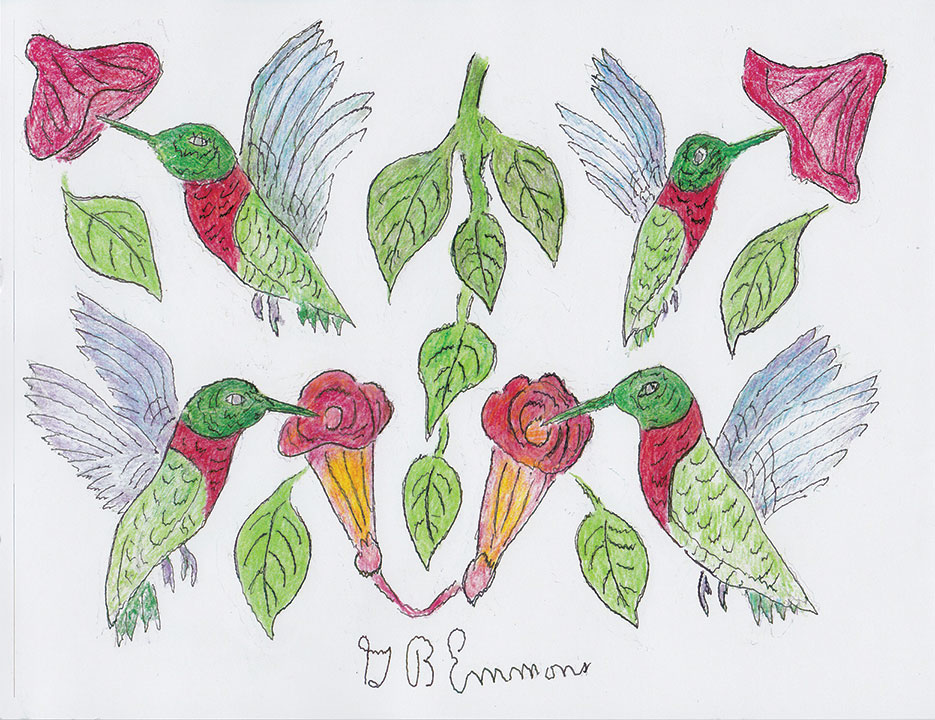The ruby-throated hummingbirds are already high profile in our gardens, flitting from flower to flower and then hovering in mid-flight before moving on to pollinate another blossom. Their favorite food plants are bright red to match their ruby-colored throat, including the red trumpet vine, red buckeye, morning glory, cardinal flower, and jewelweed.
In order to attract them to your own garden, hummingbird feeders must imitate a bright similar color of sweet-tasting liquid nectar, frequently refreshed and washed clean. The reward of a gathering is one of the most colorful avian behavior spectacles in your own backyards (see illustration).
If you should go out your back door to appreciate the gathering, they become very irritated by visitors, and true to their name to buzz around and dive bomb your head, as well as any other hummingbirds that are competing for feeding stations.
The ruby-throated hummingbirds are also considered to be polygamous because both males and females have multiple mates and do not establish as a breeding pair. After a short mating dance of aerial copulation, the female provides all the parental care from that time forward. She selects the nest site, usually near the tip of a down sloping branch in a fairly open area below a leafy canopy.
After laying several eggs, they are incubated between 10 to 14 days, and after hatching and rearing her first clutch, the ruby-throated hummingbird will later in the summer raise two or three additional families – every year.
With the progression of shorter days to find food late in the season, cooling temperatures necessitate that they must soon double their body mass before, like the monarch butterfly, beginning their autumn migration of at least 7,000 miles to winter in Mexico or Costa Rica. They make the whole trip at low levels over treetops and often non-stop over vast bodies of water, just above the waves and out of the wind.
Each leg of their passage must be timed to coordinate and coincide with the availability of food-plant energy to relay the ability to move on to the next region. They know how to communicate in this effort using tactile and visual signals to perceive in advance the favorability of sustenance ahead.
Somehow, they always seem to be ahead of the isotherm (average nightly freezing temperature). And they can see ahead the blue-violet content of the flowering flora advantageous to complete their destination of the annual life cycle for the next generation. Somehow the ruby-throated hummingbird has managed to accomplish an unbroken chain of environmental passage to ensure survival of this amazing species.
By George B. Emmons

I love Hummingbirds.
I love hummers too.. Thank you for information.
I feed two hummingbirds on my apartment patio & love watching my tiny friends. I make my own ‘nectar’ which they keep coming back for. What amazing creatures they are! Thanks for your article.
They are the most amazing bird. I sit and watch them for hours and hours. I do believe that they are the most beautiful bird on our beloved planet. Ever since I was around 9-10 yrs old I was fascinated with the colors and the pollination they do to continue the growth we all need every DAY. Some folks think that bees are a got to have for pollination. I don’t agree 100% with that. We should eradicate all bees and breed Humming birds. Our society will become calm and happy majority of time. Even that neighbor that has no heart towards anyone on his block. Show y’all the smile That’s not been seen for 50 yrs.
Pop’sHND.NV
I live in the Northwest. This year, 2021, I have seen the most ever!❤ I share your live od this beautiful bird. They left about a week ago. Now some are back. Please make sure your feeders are cleaned well. Thank you.
I love the watercolor. If it were duplicated on fabric it would make a lovely pillow for my garden room.
30 years ago I started feeding 2 hummers. Now I go through one and a half gallons of homemade nectar every day. By the end of September I look forward to my five month vacation from filling feeders. March approaches and I can’t wait to see my little guests again. They are are a handful but my life is so much richer because of these tiny jewels.
That’s amazing! I never go thru a lot, but I change it every few days in this hot weather!
Thank you for your work. I enjoy reading.
I carefully watch each summer for these beautiful ruby- throated humming birds When they arrive. I see them fluttering in the air togethe twice just over my head sqawken & squecking for the same feeding ground. I miss these lovely creatures when they leave for the winter. Just another one of Gods Creations. Kw
I love when the hummingbirds come. I enjoy feeding them and watching them on my porch for hours. They are so beautiful and fun to watch. Melissa in Grant Ok
I have just put out a humming bird feeder,and wonder what other things I can do to attract them/I live in Franklin,Tenn just outside of Nashville.We put out the feeder 3 weeks ago and no sign of a bird.Thank you.Have a Good Day